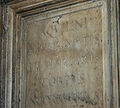Saint Aquilinus of Milan | |
|---|---|
 Carlo Urbino, The Rediscovery of Saint Aquilinus of Cologne's Corpse, a fresco behind the main altar in the Cappella di Sant'Aquilino in the Basilica of San Lorenzo, Milan in Milan, Italy. | |
| Born | Würzburg |
| Died | 650 or 1015 AD Milan |
| Venerated in | Roman Catholic Church, Eastern Orthodox Church |
| Major shrine | Basilica of San Lorenzo, Milan |
| Feast | January 29 |
| Attributes | sword through his neck |
| Patronage | hotel porters (facchini) in Milan |
Saint Aquilinus of Milan (died 1015 [1] ), also known as Aquilinus of Cologne (Italian : Sant'Aquilino), is venerated as a martyr by the Catholic Church and the Eastern Orthodox Church. He was a missionary priest and preacher in Germany and various other European countries. [2] He was canonised before the formal process of canonisation in the Catholic Church. [3]
Contents
He should not be confused with another Aquilinus, who was killed during the reign of the Arian Vandal king Hunneric in 484. [4] This 5th century Aquilinus was killed with Eugene, Geminus, Marcian, Quintus, Theodotus, and Tryphon. Bede writes about them. [4] He should also not be confused with an early bishop of Cologne named Aquilinus.


